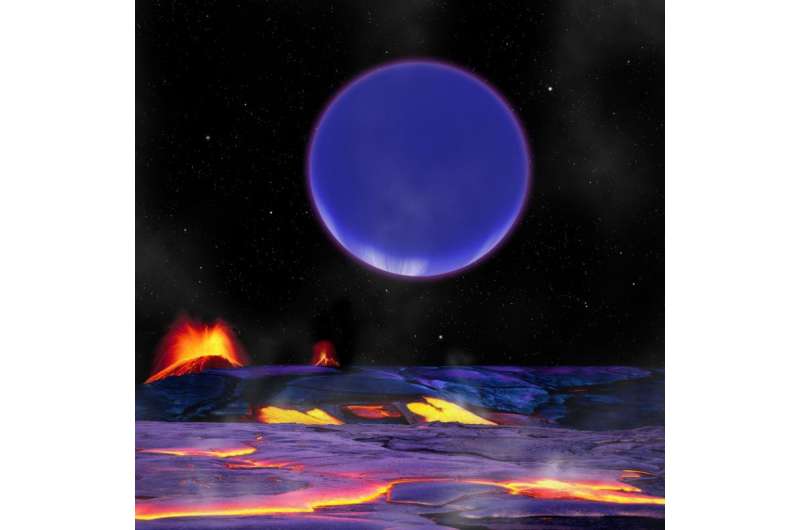February 11, 2016 report
Researchers determine physical conditions of two exoplanets in Kepler-36 system

(Phys.org)—Located about 1,530 light years from the Earth in the constellation of Cygnus, Kepler-36 is a sun-like star orbited by two known alien worlds. The inner planet, designated Kepler-36b is a so-called "super-Earth," as it is larger than our home planet but smaller than Neptune; the larger Kepler-36c, resembling the solar system's outermost planet, is described as a "mini-Neptune." What is unusual about this planetary system is that these two exoworlds have very close orbits, separated only by 0.013 astronomical units (AU)—five times the Earth-moon distance. In a new research paper published online on Feb. 9, Princeton scientists are trying to determine physical conditions and understand the evolution process of this curious, distant system.
Based on the available data from NASA's Kepler exoplanet-hunting spacecraft, James Owen from the Institute for Advanced Study in Princeton and Timothy Mortom of the Princeton University were looking for information that would be helpful in determining initial physical conditions of both planets. They performed hydrodynamic calculations to obtain a detailed evaporation model constraining the possible "birth" composition of this system. The model shows direct connection between the system's present-day observed properties and formation theories like present-day mass and radius as a function of core-mass, core composition, initial envelope-mass fraction, and initial cooling time.
"We calculate the evolution of each planet independently, including evaporation and bolometric irradiation by the central star. As we evaluate this evolution on grids of initial physical conditions, we are able to use the inferred posterior distribution of the planets' present-day properties calculated from the transit timing variations to constrain these initial conditions," the researchers wrote in the paper.
They found out that Kepler-36b has an evaporatively stripped core, while Kepler-36c has retained some of its initial envelope due to its higher core mass and that both exoworlds could have had a similar formation pathway. With the core-mass of about 4.4 Earth masses, the inner planet has an initial envelope-mass fraction of less than 10 percent. The outer planet's envelope-mass fraction is estimated to be between 15 and 30 percent and its core mass is approximately 7.3 times the mass of the Earth.
Overall, the model used by Owen and Mortom allows scientists to uncover important information about exoplanet structure shortly after formation.
"A well described birth envelope-mass, core-mass relation along with any intrinsic scatter would provide a strong constraint for any planet formation model," the paper reads.
The researchers also discovered that Kepler-36c had a long initial cooling-time, lasting more than 30 million years. This finding points to a dramatic cooling process that took place early in the planet's life. According to the scientists, such a lengthy process could be also caused by inefficient heat transport, possibly occurring after giant impacts.
What puzzles the researchers is that although the two planets are very close to each other, there is a significant disparity in densities of these celestial bodies. They suspect that some process must have occurred in order to produce such a system after six billion years of evolution.
The findings suggest that planets with larger core masses accrete a larger initial envelope, which is not unexpected theoretically. The scientists hope that with a reasonable sample of well constrained planet masses and radii, it would able to infer the birth envelope-mass/core-mass relation and to provide crucial insights into the evolution process of extrasolar planets.
"The observations necessary to begin this exploration has already been provided by Kepler, and the upcoming TESS (Transiting Exoplanet Survey Satellite) mission promises to deliver an even larger, possibly age-dependent sample," they concluded.
More information: The initial physical conditions of Kepler-36 b & c, arXiv:1511.07385 [astro-ph.EP] arxiv.org/abs/1511.07385
Abstract
The Kepler planetary system consists of two exoplanets at similar separations (0.115 & 0.128 AU), which have dramatically different densities. The inner planet has a density consistent with an Earth-like composition, while the outer planet is extremely low-density, such that it must contain a voluminous H/He envelope. Such a density difference would pose a problem for any formation mechanism if their current densities were representative of their composition at formation. However, both planets are at close enough separations to have undergone significant evaporation in the past. We constrain the core-mass, core composition, initial envelope-mass, and initial cooling-time of each planet using evaporation models conditioned on their present-day masses and radii, as inferred from Kepler photometry and transit timing analysis. The inner planet is consistent with being an evaporatively stripped core, while the outer planet has retained some of its initial envelope due to its higher core-mass. Therefore, both planets could have had a similar formation pathway, with the inner planet having an initial envelope-mass fraction of ≲10% and core-mass of ∼4.4 M⊕, while the outer had an initial envelope-mass fraction of order 15-30% and core-mass ∼7.3 M⊕. Finally, our results indicate that the outer planet had a long (≳30 Myr) initial cooling-time, much longer than would naively be predicted from simple timescale arguments. The long initial cooling-time could be evidence for a dramatic early cooling episode such as the recently proposed "boil-off" process.
© 2016 Phys.org


















